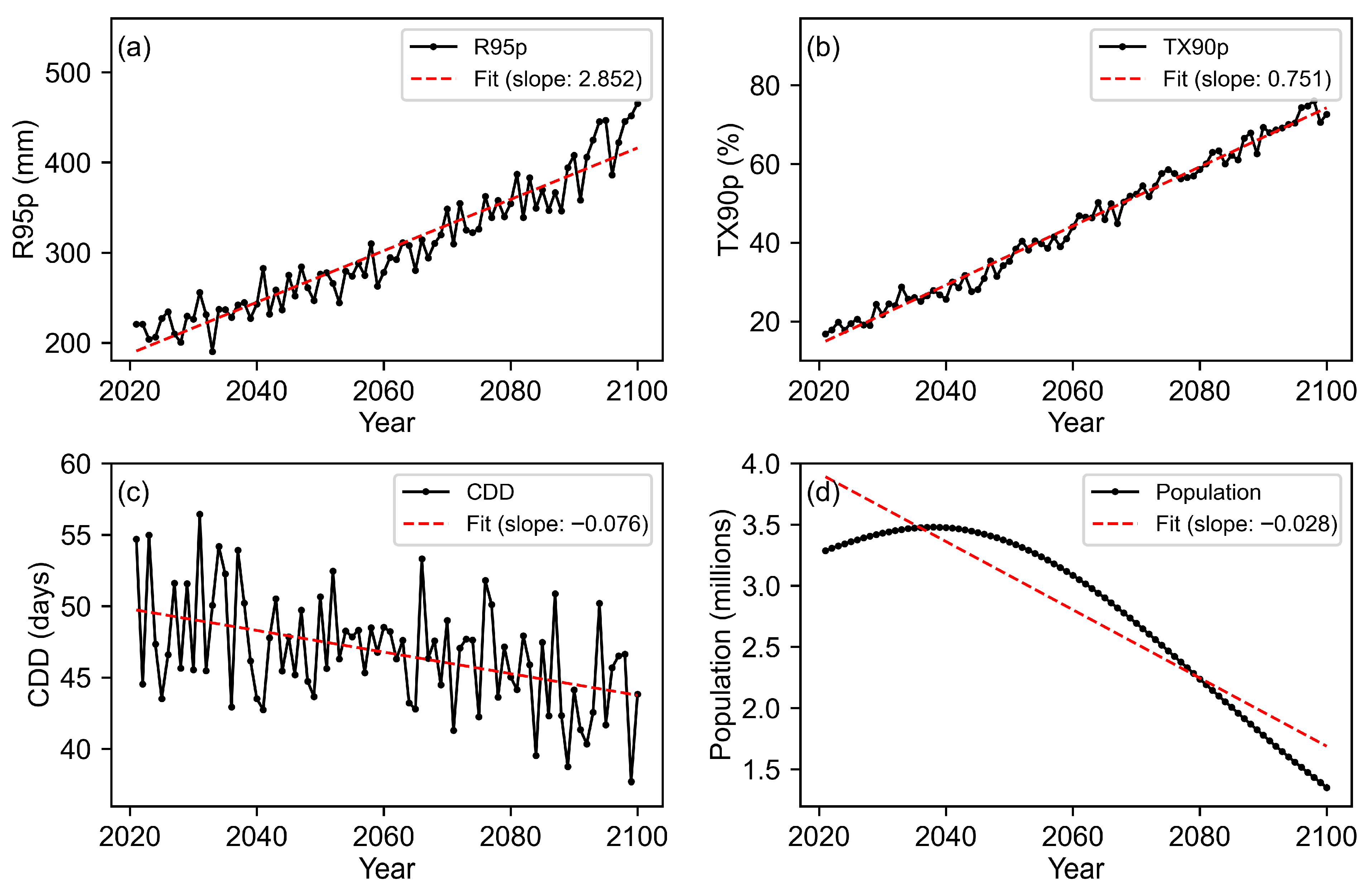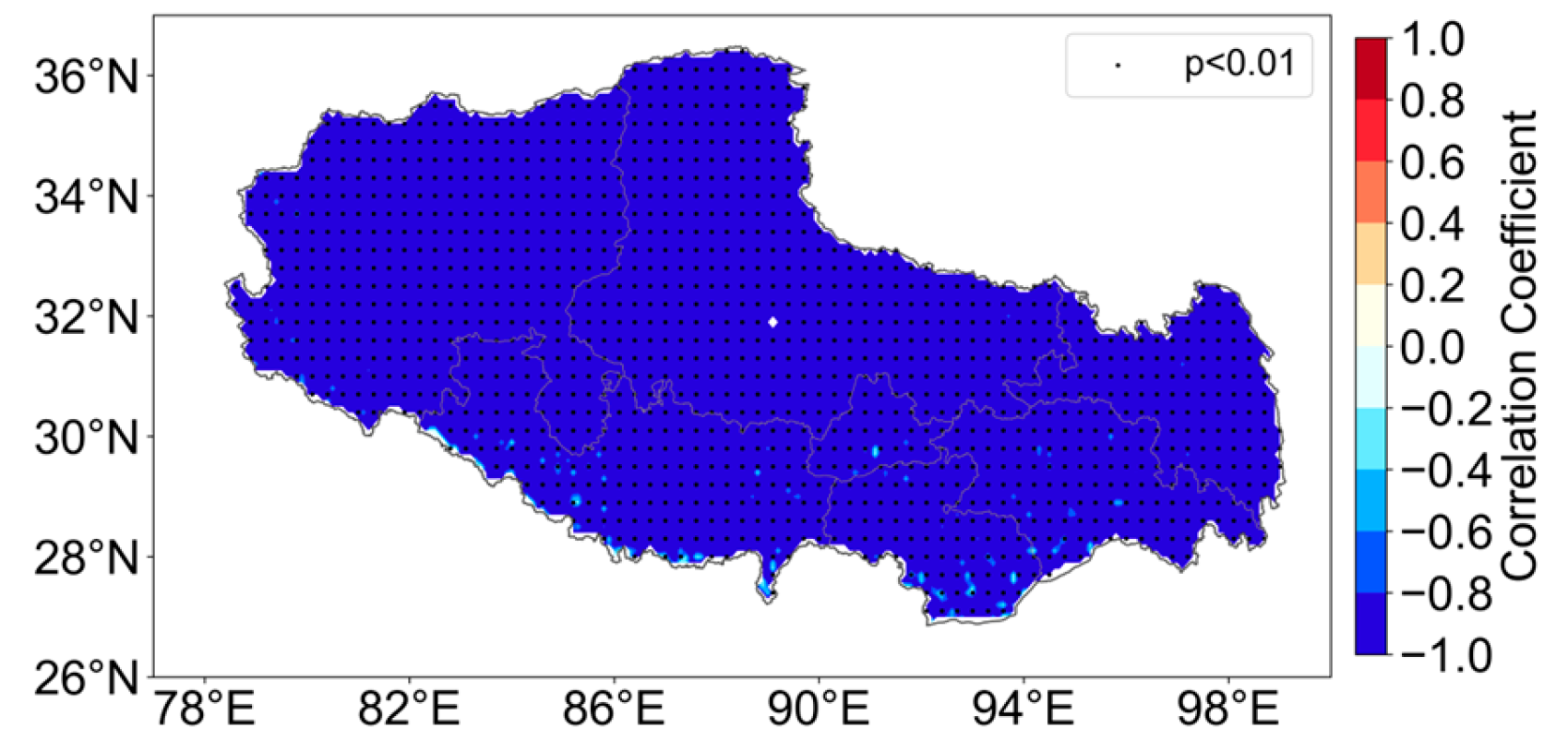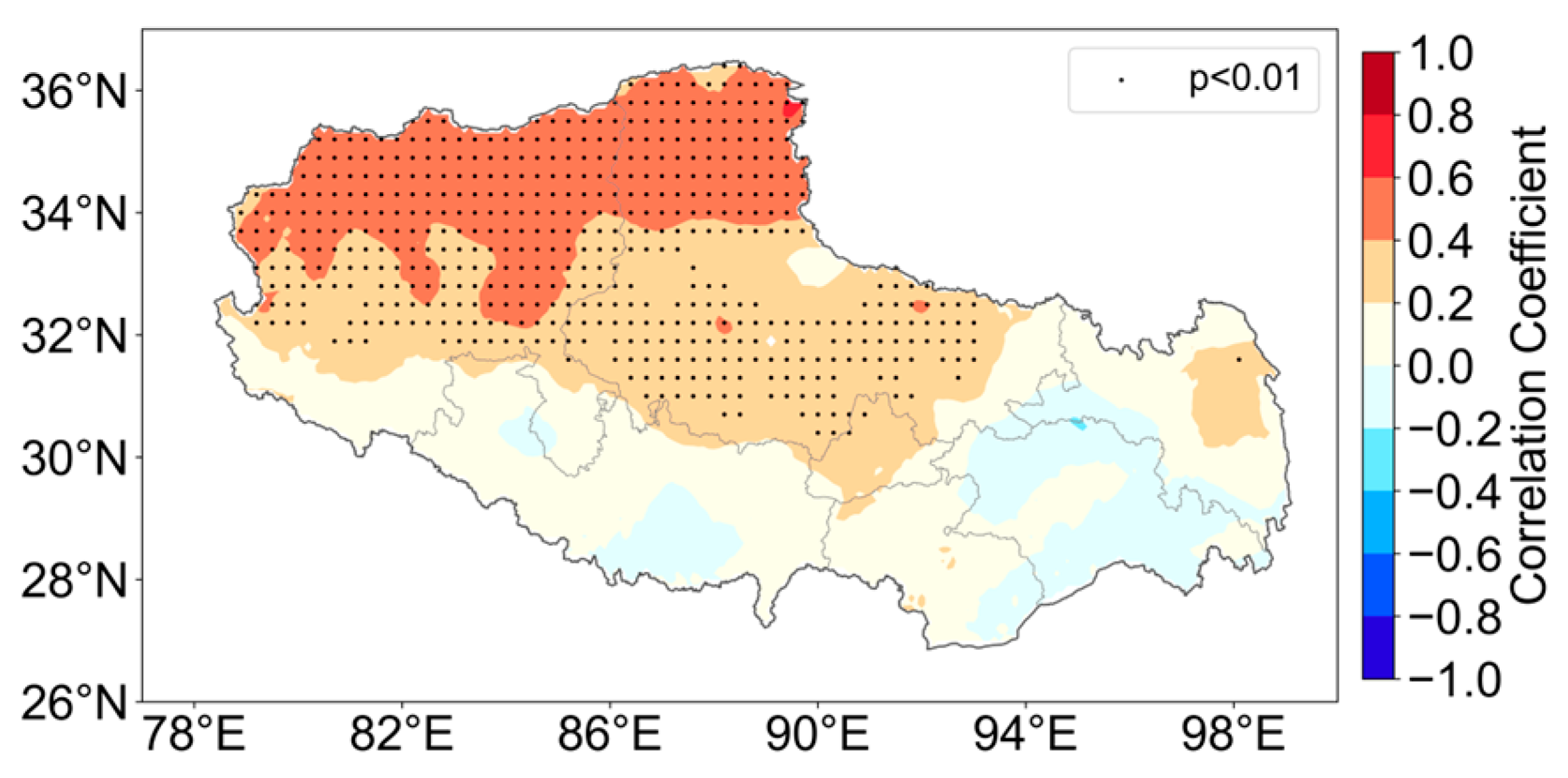Evaluating the Risk of Population Exposure and Socio-Cultural Shifts in Ethnic Tibetan Areas Under Future Extreme Climate Change
Abstract
1. Introduction
2. Data and Methods
2.1. Data Description
2.2. Description of Methods
3. Results
3.1. Time Series of Extreme Climate and Population in the Tibetan Region
3.2. Spatial Distribution of Extreme Climate and Population Changes in the Tibetan Region
3.2.1. Population
3.2.2. Extreme Precipitation
3.2.3. Extreme High Temperature
3.2.4. Extreme Drought
3.3. Exposure of Different Demographic Groups to Extreme Climate Risks
3.4. Socio-Cultural Implications of Climate and Demographic Change in Tibet
4. Discussion
5. Conclusions
Author Contributions
Funding
Institutional Review Board Statement
Informed Consent Statement
Data Availability Statement
Conflicts of Interest
References
- IPCC. Climate Change 2021: The Physical Science Basis. Contribution of Working Group I to the Sixth Assessment Report of the Intergovernmental Panel on Climate Change; Masson-Delmotte, V., Zhai, P., Pirani, A., Connors, S.L., Péan, C., Berger, S., Caud, N., Chen, Y., Goldfarb, L., Gomis, M.I., et al., Eds.; Cambridge University Press: Cambridge, UK; New York, NY, USA, 2021; in press. [Google Scholar] [CrossRef]
- Zhang, W.; Zhou, T.; Wu, P.; Song, L.; Cao, L. Anthropogenic amplification of precipitation variability over the past century. Science 2024, 385, 427–432. [Google Scholar] [CrossRef] [PubMed]
- IPCC. Climate Change 2013: The Physical Science Basis. Contribution of Working Group I to the Fifth Assessment Report of the Intergovernmental Panel on Climate Change; Stocker, T.F., Qin, D., Plattner, G.-K., Tignor, M., Allen, S.K., Boschung, J., Nauels, A., Xia, Y., Bex, V., Midgley, P.M., Eds.; Cambridge University Press: Cambridge, UK; New York, NY, USA, 2013; p. 1535. [Google Scholar] [CrossRef]
- Stott, P.A.; Stone, D.A.; Allen, M.R. Human contribution to the European heatwave of 2003. Nature 2004, 432, 610–614. [Google Scholar] [CrossRef] [PubMed]
- Raymond, C.; Matthews, T.; Horton, R.M. The emergence of heat and humidity too severe for human tolerance. Sci. Adv. 2020, 6, eaaw1838. [Google Scholar] [CrossRef]
- Saleem, A.; Anwar, S.; Nawaz, T.; Fahad, S.; Saud, S.; Rahman, T.; Khan, M.; Nawaz, T. Securing a sustainable future: The climate change threat to agriculture, food security, and sustainable development goals. J. Umm Al-Qura Univ. Appl. Sci. 2025, 11, 595–611. [Google Scholar] [CrossRef]
- Shao, H.; Zhang, Y.; Gu, F.; Shi, C.; Miao, N.; Liu, S. Impacts of climate extremes on ecosystem metrics in southwest China. Sci. Total Environ. 2021, 776, 145979. [Google Scholar] [CrossRef]
- Frame, D.J.; Rosier, S.M.; Noy, I.; Harrington, L.J.; Carey-Smith, T.; Sparrow, S.N.; Stone, D.A.; Dean, S.M. Climate change attribution and the economic costs of extreme weather events: A study on damages from extreme rainfall and drought. Clim. Change 2020, 162, 781–797. [Google Scholar] [CrossRef]
- Bell, J.E.; Brown, C.L.; Conlon, K.; Herring, S.; Kunkel, K.E.; Lawrimore, J.; Luber, G.; Schreck, C.; Smith, A.; Uejio, C. Changes in extreme events and the potential impacts on human health. J. Air Waste Manag. Assoc. 2018, 68, 265–287. [Google Scholar] [CrossRef]
- Gray, C.; Wise, E. Country-specific effects of climate variability on human migration. Clim. Change 2016, 135, 555–568. [Google Scholar] [CrossRef]
- Marchiori, L.; Maystadt, J.F.; Schumacher, I. The impact of weather anomalies on migration in sub-Saharan Africa. J. Environ. Econ. Manag. 2012, 63, 355–374. [Google Scholar] [CrossRef]
- Hunter, L.M.; Murray, S.; Riosmena, F. Rainfall patterns and U.S. migration from rural Mexico. Int. Migr. Rev. 2013, 47, 874–909. [Google Scholar] [CrossRef]
- Black, R.; Adger, W.N.; Arnell, N.W.; Dercon, S.; Geddes, A.; Thomas, D. The effect of environmental change on human migration. Glob. Environ. Change 2011, 21, S3–S11. [Google Scholar] [CrossRef]
- García-Hernández, C. Disaster, demographics, and vulnerability: Interrogating the long-term effects of an extreme weather event. Geogr. Res. 2022, 60, 549–562. [Google Scholar] [CrossRef]
- Gu, X.; Chen, P.; Fan, C. Socio-demographic inequalities in the impacts of extreme temperatures on population mobility. J. Transp. Geogr. 2024, 114, 103755. [Google Scholar] [CrossRef]
- Hermans, K.; McLeman, R. Climate change, drought, land degradation and migration: Exploring the linkages. Curr. Opin. Environ. Sustain. 2021, 50, 236–244. [Google Scholar] [CrossRef]
- Kamal, A. Climate, floods, and migration in Pakistan. Int. Migr. 2023, 61, 349–352. [Google Scholar] [CrossRef]
- Hauer, M.E.; Fussell, E.; Mueller, V.; Burkett, M.; Call, M.; Abel, K.; Wrathall, D. Sea-level rise and human migration. Nat. Rev. Earth Environ. 2020, 1, 28–39. [Google Scholar] [CrossRef]
- Yao, T.; Bolch, T.; Chen, D.; Gao, J.; Immerzeel, W.; Piao, S.; Su, F.; Thompson, L.; Wada, Y.; Wang, L.; et al. The imbalance of the Asian water tower. Nat. Rev. Earth Environ. 2022, 3, 618–632. [Google Scholar] [CrossRef]
- Sun, Y.; Hu, T.; Zhang, X. Anthropogenic influence on altitudinally amplified temperature change in the Tibetan Plateau. Environ. Res. Lett. 2024, 19, 054012. [Google Scholar] [CrossRef]
- Yao, T.; Xue, Y.; Chen, D.; Chen, F.; Thompson, L.; Cui, P.; Koike, T.; Lau, W.K.-M.; Lettenmaier, D.; Mosbrugger, V.; et al. Recent Third Pole’s rapid warming accompanies cryospheric melt and water cycle intensification and interactions between monsoon and environment. Bull. Am. Meteorol. Soc. 2019, 100, 423–444. [Google Scholar] [CrossRef]
- Yang, M.; Wang, X.; Pang, G.; Wan, G.; Liu, Z. The Tibetan Plateau cryosphere: Observations and model simulations for current status and recent changes. Earth-Sci. Rev. 2019, 190, 353–369. [Google Scholar] [CrossRef]
- Ding, J.; Cuo, L.; Zhang, Y.; Zhang, C.; Liang, L.; Liu, Z. Annual and seasonal precipitation and their extremes over the Tibetan Plateau and its surroundings during 1963–2015. Atmosphere 2021, 12, 620. [Google Scholar] [CrossRef]
- Zhang, J.; Zhao, T.; Zhou, L.; Ran, L. Historical changes and future projections of extreme temperature and precipitation along the Sichuan–Tibet Railway. J. Meteorol. Res. 2021, 35, 402–415. [Google Scholar] [CrossRef]
- Liu, L.; Gou, X.; Wang, X.; Yang, M.; Wei, S.; Pang, G.; Qie, L.; Li, Y.; Wang, Q.; Wang, T.; et al. Increases in extreme climatic events over the northeastern Tibetan Plateau and their association with atmospheric circulation changes. Atmos. Res. 2024, 304, 107410. [Google Scholar] [CrossRef]
- Huang, K.; Zhang, Y.; Zhu, J.; Liu, Y.; Zu, J.; Zhang, J. The influences of climate change and human activities on vegetation dynamics in the Qinghai–Tibet Plateau. Remote Sens. 2016, 8, 876. [Google Scholar] [CrossRef]
- Zhao, W.; Cheng, Y.; Jian, J.; Jiao, J.; Cheng, C.; Li, J.; Chen, T. Water erosion changes on the Qinghai–Tibet Plateau and its response to climate variability and human activities during 1982–2015. Catena 2023, 229, 107207. [Google Scholar] [CrossRef]
- Li, L.; Zhang, Y.; Liu, L.; Wang, Z.; Zhang, H.; Li, S.; Ding, M. Mapping changing population distribution on the Qinghai–Tibet Plateau since 2000 with multi-temporal remote sensing and point-of-interest data. Remote Sens. 2020, 12, 4059. [Google Scholar] [CrossRef]
- Yin, C.; Zhu, A.L.; Zhou, Q.; Meng, F.; Chen, R.; Liu, F.; Chen, Q.; Guo, X. Rapid urban expansion and potential disaster risk on the Qinghai–Tibetan Plateau in the 21st century. Landsc. Ecol. 2024, 39, 35. [Google Scholar] [CrossRef]
- Li, H.; Song, W. Spatiotemporal distribution and influencing factors of ecosystem vulnerability on the Qinghai–Tibet Plateau. Int. J. Environ. Res. Public Health 2021, 18, 6508. [Google Scholar] [CrossRef]
- Næss, M.W. Climate change, risk management and the end of nomadic pastoralism. Int. J. Sustain. Dev. World Ecol. 2013, 20, 123–133. [Google Scholar] [CrossRef]
- Chen, Y.; Guo, F.; Wang, J.; Cai, W.; Wang, C.; Wang, K. Provincial and gridded population projection for China under shared socioeconomic pathways from 2010 to 2100. Sci. Data 2020, 7, 83. [Google Scholar] [CrossRef]
- Klein Tank, A.M.G.; Zwiers, F.W.; Zhang, X. Guidelines on Analysis of Extremes in a Changing Climate in Support of Informed Decisions for Adaptation; Technical Report WCDMP No. 72, WMO-TD No. 1500; World Meteorological Organization: Geneva, Switzerland, 2009. [Google Scholar]
- Zhang, X.; Alexander, L.; Hegerl, G.C.; Jones, P.; Klein Tank, A.; Peterson, T.C.; Trewin, B.; Zwiers, F.W. Indices for monitoring changes in extremes based on daily temperature and precipitation data. Wiley Interdiscip. Rev. Clim. Change 2011, 2, 851–870. [Google Scholar] [CrossRef]
- Wilby, R.L.; Wigley, T.M.L. Downscaling general circulation model output: A review of methods and limitations. Prog. Phys. Geogr. 1997, 21, 530–548. [Google Scholar] [CrossRef]
- Tebaldi, C.; Knutti, R. The use of the multi-model ensemble in probabilistic climate projections. Philos. Trans. R. Soc. A Math. Phys. Eng. Sci. 2007, 365, 2053–2075. [Google Scholar] [CrossRef]
- Lange, S.; Volkholz, J.; Geiger, T.; Zhao, F.; Vega, I.; Veldkamp, T.; Reyer, C.P.O.; Warszawski, L.; Huber, V.; Jägermeyr, J.; et al. Projecting exposure to extreme climate impact events across six event categories and three spatial scales. Earth’s Future 2020, 8, e2020EF001616. [Google Scholar] [CrossRef]
- Zhang, H.; Fu, J.; Li, F.; Chen, Q.; Ye, T.; Zhang, Y.; Yang, X. Fine-scale population mapping on the Tibetan Plateau using ensemble machine learning methods and multisource data. Ecol. Indic. 2024, 166, 112307. [Google Scholar] [CrossRef]
- Gray, C.L.; Mueller, V. Natural disasters and population mobility in Bangladesh. Proc. Natl. Acad. Sci. USA 2012, 109, 6000–6005. [Google Scholar] [CrossRef] [PubMed]
- Cattaneo, C.; Peri, G. The migration response to increasing temperatures. J. Dev. Econ. 2016, 122, 127–146. [Google Scholar] [CrossRef]
- Bohra-Mishra, P.; Oppenheimer, M.; Hsiang, S.M. Nonlinear permanent migration response to climatic variations but minimal response to disasters. Proc. Natl. Acad. Sci. USA 2014, 111, 9780–9785. [Google Scholar] [CrossRef]
- Li, J.; Han, F. Strong ethics and flexible actions: The properties of traditional ecological knowledge (TEK) as key resources for socio-ecological resilience to the impacts of climate change—A case study of Baojiatun, Yunnan–Guizhou Plateau karst area, southwest China. Ecol. Soc. 2022, 27, 31. [Google Scholar] [CrossRef]
- Liu, Y.; Song, Y. The role of Chinese folk ritual music in biodiversity conservation: An ethnobiological perspective from the Lingnan region. J. Ethnobiol. Ethnomed. 2025, 21, 6. [Google Scholar] [CrossRef]
- Gordon, A.E.; Ogbu, A.I. Endangered identity: Causes and consequences of dialects’ extinction in Nigeria. Int. J. Res. Innov. Soc. Sci. 2025, 9, 1449–1457. [Google Scholar] [CrossRef]
- Yang, Y. Integrating cultural heritage into climate displacement law: The Carteret islanders case. Int. Environ. Agreements Polit. Law Econ. 2025. [Google Scholar] [CrossRef]
- You, Q.; Wu, F.; Shen, L.; Pepin, N.; Jiang, Z.; Kang, S. Tibetan Plateau amplification of climate extremes under global warming of 1.5 °C, 2 °C and 3 °C. Glob. Planet. Change 2020, 192, 103261. [Google Scholar] [CrossRef]
- Ma, M.; Tang, J.; Ou, T.; Chen, D. Subdaily extreme precipitation and its linkage to global warming over the Tibetan Plateau. J. Geophys. Res. Atmos. 2023, 128, e2023JD039062. [Google Scholar] [CrossRef]
- Kang, S.; Xu, Y.; You, Q.; Flügel, W.A.; Pepin, N.; Yao, T. Focus on climate change on the Tibetan Plateau. Environ. Res. Lett. 2010, 5, 015101. [Google Scholar] [CrossRef]
- Zhang, C.; Tang, Q.; Chen, D.; van der Ent, R.J.; Liu, X.; Li, W.; Haile, G.G. Moisture Source Changes Contributed to Different Precipitation Changes over the Northern and Southern Tibetan Plateau. J. Hydrometeorol. 2019, 20, 217–229. [Google Scholar] [CrossRef]
- Liu, R.; Wang, X.; Wang, Z. Atmospheric moisture sources of drought and wet events during 1979–2019 in the Three-River Source Region, Qinghai–Tibetan Plateau. Theor. Appl. Climatol. 2022, 149, 487–499. [Google Scholar] [CrossRef]
- Guo, X.; Tian, L. Spatial Patterns and Possible Mechanisms of Precipitation Changes in Recent Decades over and around the Tibetan Plateau in the Context of Intense Warming and Weakening Winds. Clim. Dyn. 2022, 59, 2081–2102. [Google Scholar] [CrossRef]
- Hoffmann, R.; Abel, G.; Malpede, M.; Muttarak, R.; Percoco, M. Drought and aridity influence internal migration worldwide. Nat. Clim. Change 2024, 14, 1245–1253. [Google Scholar] [CrossRef]
- Almulhim, A.I.; Alverio, G.N.; Sharifi, A.; Shaw, R.; Huq, S.; Mahmud, M.J.; Ahmad, S.; Abubakar, I.R. Climate-Induced Migration in the Global South: An In-Depth Analysis. Npj Clim. Action 2024, 3, 47. [Google Scholar] [CrossRef]
- Yang, X.; Chen, D.; Wahab, I.; Burman, A. Evidence of Climate and Economic Drivers Affecting Migration in an Unequal and Warming World. Commun. Earth Environ. 2025, 6, 782. [Google Scholar] [CrossRef]
- Linke, A.; Leutert, S.; Busby, J.; Duque, M.; Shawcroft, M.; Brewer, S. Dry growing seasons predicted Central American migration to the US from 2012 to 2018. Sci. Rep. 2023, 13, 18400. [Google Scholar] [CrossRef]
- Paerregaard, K. Adaptive Migration: Climate Change, Climate Migration, and Climate Adaptation in Peru’s Highlands Communities. Iberoam. Nord. J. Lat. Am. Caribb. Stud. 2024, 53, 20–30. [Google Scholar] [CrossRef]
- Burzyński, M.; Deuster, C.; Docquier, F.; de Melo, J. Climate Change, Inequality, and Human Migration. J. Eur. Econ. Assoc. 2022, 20, 1145–1197. [Google Scholar] [CrossRef]
- Łukaniszyn-Domaszewska, K.; Mazur-Włodarczyk, K.; Łukaniszyn, M. Unveiling the Interrelations Between Migration, Climate Change, and Energy Transitions in the Context of Socioeconomic Disparities. Energies 2025, 18, 1625. [Google Scholar] [CrossRef]










| Model | Country/Region of Origin | Horizontal Resolution (Latitudinal × Longitudinal) |
|---|---|---|
| BCC-CSM2-MR | China | 1.125° × 1.125° |
| EC-Earth3 | Europe | 0.7031° × 0.7031° |
| GFDL-ESM4 | United States | 1.25° × 1° |
| INM-CM5-0 | Russia | 2° × 1.5° |
| MIROC6 | Japan | 1.40625° × 1.40625° |
| MPI-ESM1-2-HR | Germany | 0.9375° × 0.9375° |
| MRI-ESM2-0 | Japan | 1.125° × 1.125° |
| NorESM2-MM | Norway | 1.25° × 0.9375° |
| Variable (Full Name) | Definition | Unit |
|---|---|---|
| TX90p (Warm Days Index) | Percentage of days when the daily maximum temperature exceeds the 90th percentile of the reference period (1981–2010), representing the frequency of extremely warm days. | % |
| R95p (Very Wet Days Precipitation) | Annual total precipitation from days when daily precipitation exceeds the 95th percentile of the reference period (1981–2010), indicating the intensity of very wet days. | mm |
| CDD (Consecutive Dry Days) | Maximum number of consecutive days in a year with daily precipitation less than 1 mm, reflecting drought persistence. | days |
| P (Population) | Total population within each grid or region at year t. | persons |
| Indicator (Unit) | 2021 | 2100 | Change Rate (%) |
|---|---|---|---|
| R95p (mm) | 220.46 | 465.45 | 111.13 |
| TX90p (%) | 16.81 | 72.64 | 332.12 |
| CDD (days) | 54.71 | 43.83 | −19.88 |
| Population (million persons) | 3.29 | 1.35 | −58.85 |
Disclaimer/Publisher’s Note: The statements, opinions and data contained in all publications are solely those of the individual author(s) and contributor(s) and not of MDPI and/or the editor(s). MDPI and/or the editor(s) disclaim responsibility for any injury to people or property resulting from any ideas, methods, instructions or products referred to in the content. |
© 2025 by the authors. Licensee MDPI, Basel, Switzerland. This article is an open access article distributed under the terms and conditions of the Creative Commons Attribution (CC BY) license (https://creativecommons.org/licenses/by/4.0/).
Share and Cite
Chen, J.; Zhou, X.; Liu, T.; Lin, G.; Chen, B. Evaluating the Risk of Population Exposure and Socio-Cultural Shifts in Ethnic Tibetan Areas Under Future Extreme Climate Change. Sustainability 2025, 17, 9437. https://doi.org/10.3390/su17219437
Chen J, Zhou X, Liu T, Lin G, Chen B. Evaluating the Risk of Population Exposure and Socio-Cultural Shifts in Ethnic Tibetan Areas Under Future Extreme Climate Change. Sustainability. 2025; 17(21):9437. https://doi.org/10.3390/su17219437
Chicago/Turabian StyleChen, Junqiu, Xinqiang Zhou, Tingting Liu, Guo Lin, and Bing Chen. 2025. "Evaluating the Risk of Population Exposure and Socio-Cultural Shifts in Ethnic Tibetan Areas Under Future Extreme Climate Change" Sustainability 17, no. 21: 9437. https://doi.org/10.3390/su17219437
APA StyleChen, J., Zhou, X., Liu, T., Lin, G., & Chen, B. (2025). Evaluating the Risk of Population Exposure and Socio-Cultural Shifts in Ethnic Tibetan Areas Under Future Extreme Climate Change. Sustainability, 17(21), 9437. https://doi.org/10.3390/su17219437






